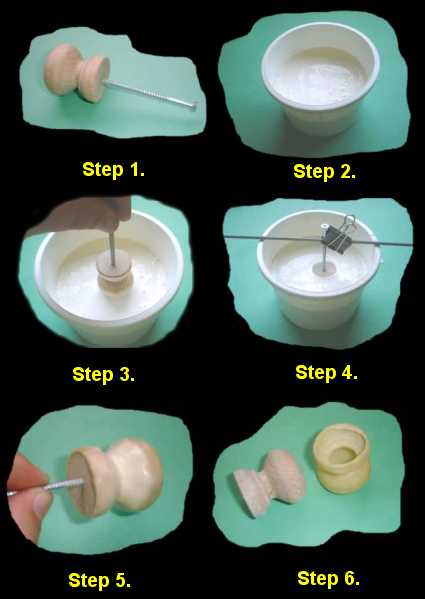These
notes are given in good faith for general guidance purposes
Other help sheets & tips are available via the
instructions & guides link above.
The following procedure takes you through the process
of making a latex mould.
In this case we are making a mould of a wooden doorknob, using the dipping
technique, enabling us to re-produce the doorknobs in pigmented transparent casting resin.
| Step 1. Ensure the surface of the doorknob which we will call the 'master' is of the quality you wish the finished casting to have, because whatever the surface of the 'master' this will be replicated on the future castings. Step 2. Pour out your liquid latex into a suitable container large enough to submerge the master. Step 3. Dip the 'master into the latex to fully cover the sides and a small area of the top, remove from latex and ensure you burst all the air bubbles that may be present, this can be done using a brush, stick or palette knife. When your satisfied you've got rid of all the bubbles, re-dip and repeat, Step 4. Dip 'master' deep enough (surface of latex just begins to cover top edges of 'master'), suspend in that position and leave for approx 20 minutes. This stage can be repeated if you feel the thickness of the mould needs to be increased. Another option is to add thickener to the liquid latex before you begin this stage, this should ensure the need to only dip once, (see notes on latex moulds). Step 5. The Latex should be touch-dry in ten minutes at normal room temperature (20°C), turning from white to a semi-transparent creamy yellow colour, and ready to peel from the master in 2-3 hours. Drying can be speeded up, using gentle heat up to about 30° C. Step 6. Before attempting to peel the mould from the master, apply talc or washing up liquid over the surface to prevent it sticking to itself when it is peeled. If the master is dipped for a longer period a thicker coating will be obtained, needing a longer drying time. To enhance this
tutorial please read the notes on Latex
Mould-making in the information & guides section. |
 |
/html>